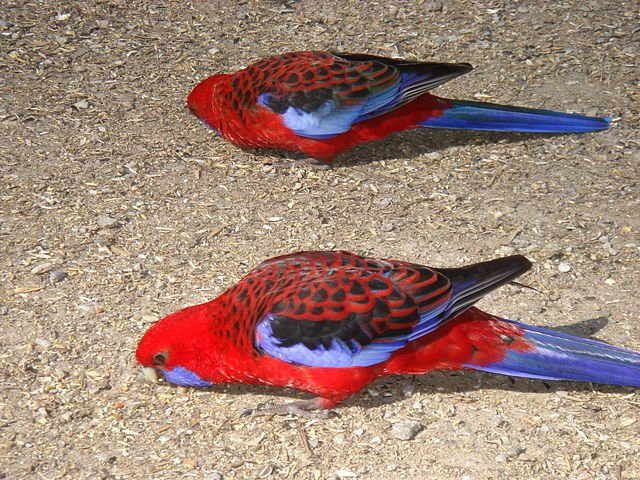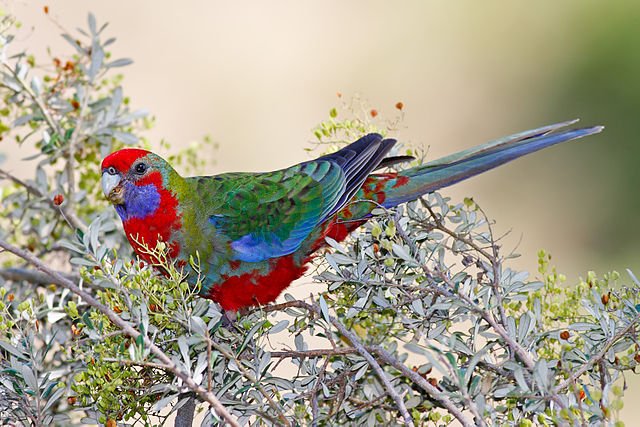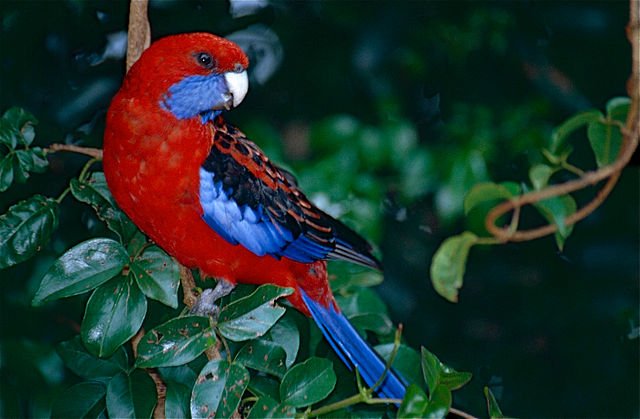A medium-sized parrot inhabiting the outer city circles, i.e., the woodlands and the open forests, and the city areas like parklands and the gardens are the beautiful Crimson Rosellas.
Also known as the Pennant Rosellas, after Thomas Pennant, a famed British naturalist, they hold the status of being an exotic parrot species of the Australian continent. And they aren’t one species. Crimson Rosella is the name that covers a whopping seven subspecies under its umbrella.
Not only do these subspecies vary in colors and markings, but there are also differences between their genders in every subspecies. Let’s learn the gender differentiation of Crimson Rosellas concerning their subspecies and behavior.
Male Crimson Rosella Visual Sexing
The male Crimson Rosellas can be differentiated from the females on a few visual parameters.
Size
The Crimson males are usually larger than their female counterparts by around 15%. The average size of a male Crimson could range anywhere between 10 to 14 inches.
Weight
On average, a male Crimson Rosella weighs around 150 grams. They are heavier than the female Crimsons.
Wingspan
The wingspan of a male Crimson usually ranges between 6.5 to 7.5 inches.
Beak
The beaks of all the male Crimson Rosella subspecies are bigger and wider than their female counterparts. The difference is prominent enough for the keen eyes to differentiate between both of the sexes.
Colors and Markings
The colors and markings of the Crimsons vary with each subspecies. Let us specify the characteristics for all of them one by one for better clarity.
Platycercus Elegans Elegans – This subspecies is commonly found in coastal areas of New South Wales and throughout Victoria. The male has a dark red plumage with a rich purple or blue patch on the cheek. The back is black with spots of dark red.
The wing bend and the outer covert of the wings are also rich purple/blue. The ends of the primary flight feathers and the tail feathers are also purple. The beak is grey/white. The tail is also blue with a slight white tip.

Photo Credits: JJ Harrison (https://www.jjharrison.com.au/) / CC BY-SA
Platycercus Elegans Nigrescens – This subspecies commonly inhabits the north-east coast of Queensland. The males share all the color and markings with their P.E. Elegans cousins and are almost identical to them in every aspect except the color intensity.
The red shade in the Nigrescens is noticeably deeper and much darker than the Elegans. Additionally, the Nigrescens males are comparatively smaller in size than the Elegans which makes it easy to distinguish them both from each other.
Platycercus Elegans Melanoptera – This subspecies mainly reside on the Kangaroo Island and their crimson plumage is also a deeper shade of red just like P.E. Nigrescens. But what makes the males of this subspecies still stand apart from all the crimson-colored subspecies is that they happen to be the largest of them all. The extra size is enough of an indicator to tell them apart.
Platycercus Elegans Flaveolus – They are commonly found along the Murray River and its several tributaries. The crimson color of the previous three discussed subspecies is replaced by a brighter pale yellow tone. The males have a flatter head and a noticeably larger body. The color of the body and the cheek patches are much brighter in males.
Platycercus Elegans Fluerieuensis – Primarily inhabiting Adelaide and the surrounding areas, these subspecies have a pale to strong orangish-red plumage. The males have much larger bodies and a visibly flatter head.
Behavior
There are behavioral differences between both the sexes of the Crimson Rosella. The males have been known to be more aggressive. So much so that their anger is enough of a factor to set them apart from the opposite sex, especially during the breeding season.
His aggression is mostly directed towards his mate. Not only this, but the males also get extremely territorial and nippy if housed with other Crimson pairs.
Female Crimson Rosella Visual Sexing
The female Crimson Rosellas can be distinguished from the males considering certain visual parameters.
Size
The size of the female Crimsons is slightly smaller than the males. It ranges somewhere between 8 to 12 inches.
Weight
Lighter than the male Crimsons, the females weigh around 110 grams at an average.
Wingspan
The wingspan of the female Crimson also varies with her size. The range is around 5.5 to 6.5 inches but it is still narrower than the male Crimsons.
Bill
The beaks of the female Crimsons are not only smaller in size but also narrower than the male Crimsons. Also, they are distinguishably more rounder.
Colors and Markings
Platycercus Elegans Elegans – The subspecies is commonly found in coastal areas of New South Wales and throughout Victoria sharing tree-top nests with their mates. The female is similar to the difference in the tail’s color marking. The Female’s tail is washed with a dull tone of green with the underwing flaps being white. Also, the beak is relatively smaller.
Platycercus Elegans Nigrescens – Inhabiting the north-east coast of Queensland along with their mates, the Nigrescens females are similar to the female P.E. Elegans. But they can be distinguished from the Elegans subspecies as they are a relatively much darker shade of red and noticeably smaller in size.
To learn about Crimson Rosella Colors more in-depth try here:
https://parrotquaker.com/crimson-rosella-colors/
Platycercus Elegans Melanoptera – Residing with their mates on the Kangaroo Island, they are dark enough to be told apart from the P.E. Elegans females. But the plumage color shade and markings are almost identical to the Nigrescens females. What makes the female Melanoptera stand out from the Nigrescens is their size. They happen to be the largest Crimson female members of the whole Crimson Rosella’s crimson subspecies.
Platycercus Elegans Flaveolus – Cohabiting the Murray River with their mates and its several tributaries, the crimson color is replaced by a brighter pale yellow tone in this subspecies. The females have a visible rounder head and a comparatively smaller body. The color of the body and the cheek patches are a paler shade against males.
Platycercus Elegans Fluerieuensis – Inhabiting Adelaide and the surrounding areas with their mates, these subspecies have a pale to strong orangish-red plumage. The females have much smaller bodies and a rounder head. Additionally, the plumage of the females is suffused with a much orangish tinge against their male counterparts that have comparatively a lesser orangish plumage.

Photo Credit:
derivative work: Snowmanradio (talk)Crimson_Rosella_(Platycercus_elegans)-on_feeder.jpg:Mfunnell at en.wikipedia / CC BY-SA
Differences in color between juveniles and adults. Juvenile on right with some green color, and adult on left.
Behavior
Observing the behavior of a Crimson pair, one can easily tell apart the female Crimson being the calmer one. Female Crimsons do not get as aggressive as the males do. Neither are they much territorial when housed with their mates. Though they can be a bit aggressive and nippy towards another Crimson pair sharing the same cage. But the aggression will be milder when compared to her mate.
Crimson Rosella Sexing
Though it is not a sure-shot way, more often than not, everyone depends on the above mentioned visual sexing techniques to tell apart both the genders. But if one has to be more than sure about the Crimson’s gender, then one of the following two methods are the only proven ones:
DNA Sexing
The first method is the DNA sexing by getting the DNA of the Crimson tested. Under this method, the vet takes a blood sample of the bird and sends it to the laboratory for examination. The resultant report mentions the gender of the bird.
Additionally, one can also get the DNA tested with the help of a feather of the bird. This can be done by plucking a few feathers of the bird from his body and sending them directly to the laboratory for DNA testing. The report clarifies the confusion, if any, about the bird’s sex. If one is doing this at home while plucking his pet bird’s feathers, care must be taken as many times, the bird ends up catching infection due to improper feather plucking.
Surgical Sexing
This method is a bit older than the DNA sexing technique. But after the latter, surgical sexing has been adopted less by one and all for its invasive nature. The method involves checking the organs of the bird to determine his gender.
The bird is first given anesthesia to reduce the surgical pain he’ll experience during the testing. Then a small region of his abdomen is shaved to make an incision. The expert then makes an endoscope pass through that incision to examine his reproductive organs.
Though the method is accurate as DNA sexing, it is being less used as it causes much pain and stress to the bird. Also, post-surgical care is a must to maintain the bird’s health and prevent him from infection.
Summing Up
Like many other parrot species, Crimson Rosellas are also monomorphic, i.e., have a similar appearance and can hardly be told apart. But unlike a few other species like Quaker parrots or Budgies, there is a slight dimorphism in them. That is they can still be distinguished from each other given their strikingly different colors and markings of certain body parts. But the sure-shot method is still a scientific one that eliminates all the gender confusion.
Read more about Crimson rosella Colors:
https://parrotquaker.com/crimson-rosella-colors/



